
22.10. IMPLICIT FUNCTION THEOREM 729
Proof: First of all, why does the series make sense?∥∥∥∥∥ q
∑k=p
Ak
∥∥∥∥∥≤ q
∑k=p
∥∥∥Ak∥∥∥≤ q
∑k=p∥A∥k ≤
∞
∑k=p
rk ≤ rp
1− r
and so the partial sums are Cauchy in L (X ,X) . Therefore, the series converges to some-thing in L (X ,X) by completeness of this normed linear space. Now why is it the inverse?
∞
∑k=0
Ak (I−A) = limn→∞
n
∑k=0
Ak (I−A) = limn→∞
(n
∑k=0
Ak−n+1
∑k=1
Ak
)= lim
n→∞
(I−An+1)= I
because∥∥An+1
∥∥≤ ∥A∥n+1 ≤ rn+1. Similarly,
(I−A)∞
∑k=0
Ak = limn→∞
(I−An+1)= I
and so this shows that this series is indeed the desired inverse.Next suppose A ∈ O so A−1 ∈ L (X ,X) . Then suppose ∥A−B∥ < r
1+∥A−1∥ ,r < 1.
Does it follow that B is also invertible?
B = A− (A−B) = A[I−A−1 (A−B)
]Then
∥∥A−1 (A−B)∥∥≤ ∥∥A−1
∥∥∥A−B∥< r and so[I−A−1 (A−B)
]−1 exists. Hence
B−1 =[I−A−1 (A−B)
]−1A−1
Thus O is open as claimed. As to continuity, let A,B be as just described. Then using theNeuman series,
∥IA−IB∥=∥∥∥A−1−
[I−A−1 (A−B)
]−1A−1
∥∥∥=
∥∥∥∥∥A−1−∞
∑k=0
(A−1 (A−B)
)kA−1
∥∥∥∥∥=∥∥∥∥∥ ∞
∑k=1
(A−1 (A−B)
)kA−1
∥∥∥∥∥≤
∞
∑k=1
∥∥A−1∥∥k+1 ∥A−B∥k = ∥A−B∥∥∥A−1∥∥2
∞
∑k=0
∥∥A−1∥∥k(
r1+∥A−1∥
)k
≤ ∥B−A∥∥∥A−1∥∥2 1
1− r.
Thus I is continuous at A ∈ O .
Lemma 22.10.4 LetO ≡ {A ∈L (X ,Y ) : A−1 ∈L (Y,X)}
and letI : O →L (Y,X) , IA≡ A−1.